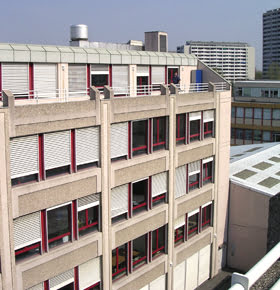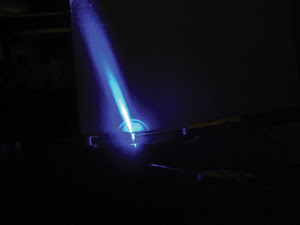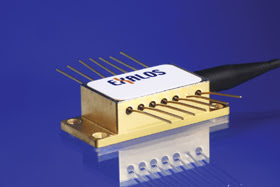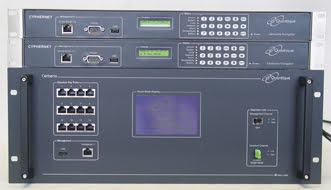Some of its best-known exports may include watches, chocolate and cheese, but Switzerland also is home
to a healthy photonics industry, which, according to an October 2009 report by Swiss-based
consulting firm Optech Consulting, has generated a direct revenue of about CHF3
billion ($2.8 billion), ranking it second per capita in Europe.

Quantum photonics specialist ID Quantique of Geneva was co-founded
by Grégoire Ribordy with the support of the University of Geneva. Courtesy
of ID Quantique.
Some of the country’s most important photonics firms include
ID Quantique of Geneva, a quantum photonics specialist; Exalos AG of Schlieren,
a global producer of superluminescent light-emitting diodes (SLEDs); Oerlikon Corp.
of Pfäffikon, a leading company in the field of solar, thin-film, vacuum-propulsion,
textile and precision technology; and Alpes Lasers SA of Neuchâtel, Novagan
of Lausanne and TimeBandwidth of Zurich. The country also is home to offices of
some of the biggest optics/photonics players, including Trumpf, Lasag, Leica and
Tecan.
With a population of just 7.6 million, Swiss companies must depend
heavily on foreign trade for success. In some cases, more than 90 percent of goods
and services are exported. Most businesses are small or medium-size. In 2001, more
than 99 percent of enterprises had fewer than 250 full-time workers, employing about
two-thirds of the total work force. About 88 percent were microenterprises, with
fewer than 10 employees.

Shown is a blue SLED made by Exalos/EPFL in the framework of the CTI project. Courtesy
of Exalos and of the Laboratory of Advanced Semiconductors for Photonics and Electronics.
Long-standing reputation
Switzerland has a long-standing reputation for carrying out high-standard
scientific research and development. This is reflected in its government policies
– including generous funding schemes – which are aimed at ensuring that
Switzerland does not fall behind the world leaders.
For example, the Swiss National Science Foundation was established
in 1952 to support basic research in all disciplines and to invest in applied research
in scientific fields. Thanks to funding totaling CHF46 million ($43.5 million) invested
since 2001, the National Centre of Competence in Research Quantum Photonics (NCCR
QP) based in Lausanne has since generated more than 2 1/2 times this amount in the
field.
Switzerland is home to some of the highest ranked universities
in the world. The Federal Institutes of Technology in Zurich (ETHZ), including its
sister institution in Lausanne, Ecole Polytechnique Fédérale de Lausanne
(EPFL), has helped Switzerland develop its strong reputation in research, and both
centers boast several examples of successful technologies transferred into real-world
applications.
BeamExpress, also of Lausanne, is a privately held company developing
long-wavelength vertical-cavity surface-emitting lasers for high-speed optical communications
as well as gas spectrometry in cooperation with EPFL.
Another example is the first blue-violet SLED demonstrated by
Exalos in collaboration with professor Nicolas Grandjean and his team at EPFL, with
the support of NCCR and CTI (a financing platform for Swiss high-tech companies).

This image depicts one of Exalos’ superluminescent light-emitting
diode (SLED) products, which are developed in partnership with some of Switzerland’s
top-rated academic centers. Courtesy of Exalos.
But the strength of Swiss research is perhaps most commonly associated
with its groundbreaking efforts in quantum photonics. The SwissQuantum project was
set up by the University of Geneva, the University of Applied Sciences of Western
Switzerland and ID Quantique to demonstrate long-term operation of quantum cryptography
technology in a meshed network setting. Since the network was deployed in April
2009, it has logged more than 12,000 hours of cumulative operation, marking the
first quantum key distribution technology to operate for months with real traffic.

The Cerberis Solution from ID Quantique comprises high-speed layer
2 encryption engines with the unconditional security of quantum key distribution
technology. Courtesy of ID Quantique.
Although photonics research in Switzerland is strong, thanks largely
to excellent government funding, the Swiss government stops short of funding the
photonics industry or startups. Technology transfer from the laboratory to real-world
applications is left to academic initiatives such as the Industrial Project Program
created by the NCCR QP. The program is dedicated to supporting technology transfer
of research made in the network to real applications in the photonics industry.
“This program has proven to be really successful for various
reasons,” said Sandra Pochon, managing director of NCCR QP. “This program
is responding to a real need by filling a gap amongst other supporting tools, and
it leads to finalized projects with real jobs and sometimes the creation of startups
in promising fields.”
Swiss startups supported by academic initiatives
With no government funding to help seed new companies, some startups
in Switzerland can face daunting challenges. One such company that successfully
overcame all initial hurdles is ID Quantique. According to Grégoire Ribordy,
CEO and co-founder, the support of the University of Geneva is what enabled the
company to build on the quantum key distribution technology formulated there.
“It was relatively easy in the sense that the University
of Geneva was very supportive and flexible. Technology transfer people were ready
to find customized solutions for us, and this is a very good approach,” Ribordy
said. “I think that the cooperation with academic research centers is excellent.
These organizations are flexible and interested in working with industrial partners,
even if they are small. Moreover, funding instruments for such collaborations are
available.”
Cooperation with other firms can be somewhat more difficult, however.
Ribordy speculates that this may be a result of the fact that the Swiss photonics
industry consists of mostly small companies focusing on their respective niche areas.
“This means that there is little overlap between different firms, making collaborations
more difficult.”
Dr. Uwe Achatz, vice president of strategic marketing and business
development at Exalos, said that his company, whose technology was first developed
at ETHZ, benefits from strong cooperation with both its academic and industrial
partners.
“Most of our current products are the result of fruitful
cooperation between Exalos and our partners,” he said. “Without these
cooperations, it would have been much more difficult to reach the point we are at
today.”
Although today’s SLED market is still relatively small,
the number of applications using this technology is increasing dramatically year
after year. And as a fabless firm, Exalos relies heavily on established partner
companies from many areas for access to outstanding technologies.
“Overall, a combination of both the close cooperation with
universities and industrial partners supported by grants and the skilled workers
in a fabless environment has helped us to become the worldwide number one [manufacturer]
for SLEDs,” Achatz said. “The founding of the Swiss Photonics and Laser
Network (SLN) was also helpful in bringing the right people together and improving
overall cooperation.”
The SLN was launched by Swiss institutes active in the field of
materials processing with laser beam tools. The nonprofit organization is an important
network for the Swiss photonics industry and serves the entire photonics field,
including photonics manufacturing, imaging and photonics life sciences, optical
communications, photovoltaics and lighting.
International talent
With its unique location in the heart of Europe, Switzerland has
access to a wealth of international talent to supplement its workforce. In fact,
foreigners account for about 21 percent of the resident population.
According to Grandjean at EPFL, many people are attracted to Switzerland
because of its excellent benefits packages and its access to state-of-the-art facilities
and financing tools. And this trend is mirrored within EPFL itself, which claims
to be one of the most cosmopolitan universities in the world, educating students
from 107 countries.
But thanks to much home-grown talent, the photonics industry in
Switzerland can take its pick of candidates. ID Quantique, for example, taps into
the particle physics community and takes advantage of the presence of the European
Organization for Nuclear Research (CERN) in Geneva.
Achatz agrees: “A lot of our personnel have international
backgrounds and come from countries all over the globe. This could indicate that
there could be more resources in Switzerland. However, many of the leading positions
are filled from the universities and technical colleges in Switzerland.”
Because the country has no natural resources, other commodities,
such as education, knowledge and research, have become very important. It is perhaps
this attitude coupled with a well-deserved reputation for turning out hard workers
that has helped the photonics industry flourish in Switzerland. And with such strong
emphasis on research and development, surely the message must be: Watch this space.